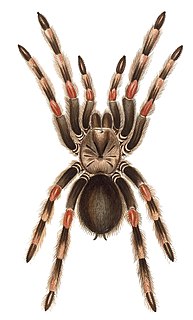
The chelicerae are the mouthparts of the Chelicerata, an arthropod group that includes arachnids, horseshoe crabs, and sea spiders. Commonly referred to as "jaws", chelicerae may be shaped as either articulated fangs, or similarly to pincers. Some chelicerae, such as those found on nearly all spiders, are hollow and contain venom glands, and are used to inject venom into prey or a perceived threat. For example, in Pisaurina mira, also known as the nursery web spider, the chelicerae is utilized to snatch the prey once it becomes within reach, facilitating the "sit-and wait ambush predator" behavior. Both pseudoscorpions and harvestmen have structures on their chelicerae that are used for grooming.

The Araneomorphae are an infraorder of spiders. They are distinguished by having chelicerae (fangs) that point diagonally forward and cross in a pinching action, in contrast to the Mygalomorphae, where they point straight down. Most of the spiders that people encounter in daily life belong to the Araneomorphae.

Atypidae, also known as atypical tarantulas or purseweb spiders, is a spider family containing only three genera. They are accomplished ambush predators that spend most of their time in a sock-like, silken retreat on the ground from where they kill their prey.

The cephalothorax, also called prosoma in some groups, is a tagma of various arthropods, comprising the head and the thorax fused together, as distinct from the abdomen behind. The word cephalothorax is derived from the Greek words for head and thorax. This fusion of the head and thorax is seen in chelicerates and crustaceans; in other groups, such as the Hexapoda, the head remains free of the thorax. In horseshoe crabs and many crustaceans, a hard shell called the carapace covers the cephalothorax.

Brachypelma smithi is a species of spider in the family Theraphosidae (tarantulas) native to Mexico. It has been confused with Brachypelma hamorii; both have been called Mexican redknee tarantulas. Mexican redknee tarantulas are a popular choice as pets among tarantula keepers. Many earlier sources referring to B. smithi either relate to B. hamorii or do not distinguish between the two species. B. smithi is a terrestrial tarantula native to Pacific coast of the Mexican state of Guerrero.
Cyriopagopus hainanus is a species of spider in the family Theraphosidae (tarantulas), found in China. It is one of a number of species from China and Vietnam known as "Chinese bird spider". It produces a venom containing numerous compounds capable of blocking neurotransmitters, including neurotoxic peptides called hainantoxins.

Cyriopagopus schmidti is a species of spider in the family Theraphosidae (tarantulas), found in China and Vietnam. It is one of a number of species known as "Chinese bird spider" and "Chinese earth tiger". Haplopelma huwenum was synonymized with this species in 2008. Spiders under this name and its synonyms have been shown to produce toxins called huwentoxins.

Tarantulas comprise a group of large and often ″hairy″ spiders of the family Theraphosidae. Currently, about 1,000 species have been identified. The term tarantula is usually used to describe members of the family Theraphosidae, although many other members of the same infraorder (Mygalomorphae) are commonly referred to as "tarantulas" or "false tarantulas". Some of the more common species have become popular in the exotic pet trade. Many New World species kept as pets have urticating hairs that can cause irritation to the skin, and in extreme cases, cause damage to the eyes.

Poecilotheria ornata, known as the fringed ornamental or ornate tiger spider, is a large arboreal tarantula, which is endemic to Sri Lanka. Their legspan sometimes reaches 10 inches (25 cm) in females, and is probably the second largest of the genus, behind Poecilotheria rufilata.
The Selenogyrinae are a subfamily of tarantulas found in Africa and Asia.
Euphrictus is a genus of tarantula which is found in Africa. It is part of the subfamily Selenogyrinae.
Annandaliella pectinifera is a species of tarantula, a type of spider, in the subfamily Selenogyrinae. It is endemic to India.

Aphonopelma marxi is a species of spider in the family Theraphosidae (tarantulas), found in United States. Aphonopelma behlei and A. vogelae, at one time considered separate species, are now considered to be synonyms.
Selenogyrus austini is a theraphosid spider. As of February 2016, it is a member of the selenogyrinae. It is native to Sierra Leone.
Selenogyrus is a genus of spider, or more specifically, selenogyrine theraphosid. The type species is Selenogyrus caeruleus.
Selenogyrus africanus is a species of tarantula, which is native to the Ivory Coast and is a member of the Selenogyrinae subfamily.

Poecilotheria subfusca, or the ivory ornamental, is a spider in the tarantula family, Theraphosidae. It is endemic to Sri Lanka. As of February 2019, the World Spider Catalog regarded Poecilotheria bara as a synonym. Other sources, particularly in the pet trade, have treated highland and lowland forms as distinct species, with the lowland forms being P. bara.

Avicularia purpurea, also called purple tree tarantula, Ecuadorian purple tarantula or Ecuador purple pinktoe, is a species of spider belonging to the family Theraphosidae (tarantulas).
Selenogyrus brunneus is a species of tarantula, found in West Africa.
Selenogyrus caeruleus is a species of tarantula native to Sierra Leone.










